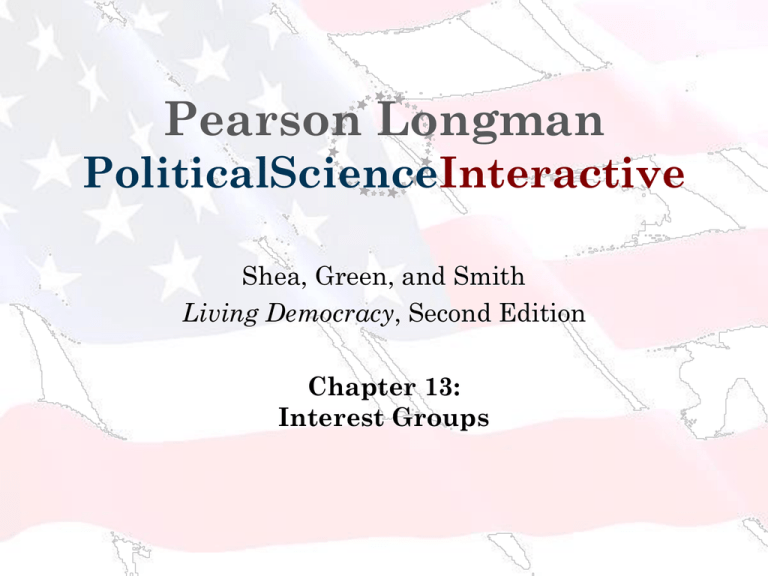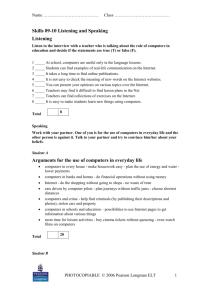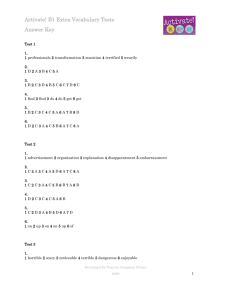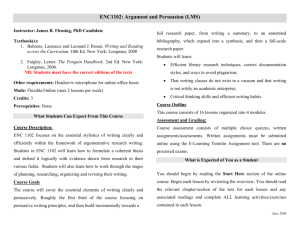
Pearson Longman
PoliticalScienceInteractive
Shea, Green, and Smith
Living Democracy, Second Edition
Chapter 13:
Interest Groups
Chapter 13: Interest Groups
Interest Groups
Motivation to Join Interest Groups
Single-issue interest groups
Multi-issue interest groups
Shea, Green, and Smith, Living Democracy, Second Edition
Copyright 2009 Pearson Longman
Chapter 13: Interest Groups
Pathways of Action: LULAC
League of United Latin American
Citizens
Founded 1929
700 councils, 115,000 members
Successful in advocating for Latinos
Provides services, encourages
volunteerism
Shea, Green, and Smith, Living Democracy, Second Edition
Copyright 2009 Pearson Longman
Chapter 13: Interest Groups
Functions of Interest Groups in a
Democratic Society
Five functions of interest groups
in the United States
1. Represent constituents
2. Provide means of
political participation
3. Educate the public
4. Agenda building
5. Serving as government
watchdogs
Shea, Green, and Smith, Living Democracy, Second Edition
Copyright 2009 Pearson Longman
Chapter 13: Interest Groups
The Interest Group Explosion
Number of national-level
interest group organizations
in the United States
• 1959: 5,843
• 1970: 10,308
• 1980: 14,726
Why has there been
such a large growth
in interest groups
over the last 40
years?
• Mid-1990s: 22,200
Shea, Green, and Smith, Living Democracy, Second Edition
Copyright 2009 Pearson Longman
Chapter 13: Interest Groups
Types of Interest Groups
Economic Groups
Public Interest
Groups
Think Tanks and
Universities
Governmental
Units
Shea, Green, and Smith, Living Democracy, Second Edition
Copyright 2009 Pearson Longman
Chapter 13: Interest Groups
Difficulties in Mobilization
Mancur Olson, The Logic of
Collective Action (1971)
– Free-rider problem
– Cost of group formation
– Lack of a sense of
political efficacy
Shea, Green, and Smith, Living Democracy, Second Edition
What are
some of the
barriers to
collective
action?
Copyright 2009 Pearson Longman
Chapter 13: Interest Groups
Overcoming Organizational Barriers
Selective benefits can be used to
overcome organizational barriers
Material benefits
Solidary benefits
Purposive benefits
Shea, Green, and Smith, Living Democracy, Second Edition
Copyright 2009 Pearson Longman
Chapter 13: Interest Groups
Overcoming Organizational Barriers
Membership Required
Unions are a good example.
Some employers make
agreements to only hire
union workers.
Shea, Green, and Smith, Living Democracy, Second Edition
Copyright 2009 Pearson Longman
Chapter 13: Interest Groups
The Role of Interest Group Leaders
Cesar Chavez and the UFW
Grew up as a migrant
worker
1962, organized National
Farm Workers Association
UFW formed from NFWA
and other organizations
Led march across California
Hunger strike
Shea, Green, and Smith, Living Democracy, Second Edition
Copyright 2009 Pearson Longman
Chapter 13: Interest Groups
Pathways of Change From Around the World:
Kris Woodall
Worked with Richard Ellarby to found the
Coalition of Hull’s Young People
Worked to change city ordinances, and to
help an Afghani asylum seeker
Shea, Green, and Smith, Living Democracy, Second Edition
Copyright 2009 Pearson Longman
Chapter 13: Interest Groups
Inside and Outside Lobbying
Inside Lobbying
Outside Lobbying
Openly appealing to
public officials in the
legislature and executive
branches. Involves
“gaining access”
to an insider in the
lawmaking process.
Appealing directly to
the public in order to
influence officials. 90
percent of interest
groups engage in this
type of lobbying.
Shea, Green, and Smith, Living Democracy, Second Edition
Copyright 2009 Pearson Longman
Chapter 13: Interest Groups
Student Profile: Alia Alnahas
High school student
2006, founded United Student Activists
Peace through nonviolent political
action, healthy energy sources, healthy
environment
Shea, Green, and Smith, Living Democracy, Second Edition
Copyright 2009 Pearson Longman
Chapter 13: Interest Groups
Pathways Profile:
Recording Artists Coalition
Founded in 1998 by Don
Henley and Sheryl Crow
Represents recording artists
Uses legal pathways,
grassroots mobilization, and
public events
Shea, Green, and Smith, Living Democracy, Second Edition
Copyright 2009 Pearson Longman
Chapter 13: Interest Groups
Grassroots Mobilization Pathway
Grassroots
Mobilization
The identification,
recruitment, and
mobilization of
constituent-based
political strength
capable of
influencing
political decisions.
Shea, Green, and Smith, Living Democracy, Second Edition
Copyright 2009 Pearson Longman
Chapter 13: Interest Groups
Grassroots Mobilization Pathway
Traditional Tactics
1.
Direct contact
2.
Direct mail
3.
Events and activities
4.
Mass demonstrations
5.
Boycotts
6.
Litigation
Shea, Green, and Smith, Living Democracy, Second Edition
Copyright 2009 Pearson Longman
Chapter 13: Interest Groups
Grassroots Mobilization Pathway
Newer Tools
1.
Advertorials
2.
Advertising
3.
Sponsored television
shows
4.
Blogs
5.
Email campaigns
6.
Use of Internet to
organize
Shea, Green, and Smith, Living Democracy, Second Edition
Copyright 2009 Pearson Longman
Chapter 13: Interest Groups
Campaign Activities
Most interest groups
take part in electoral
politics by rating
and endorsing
candidates.
Shea, Green, and Smith, Living Democracy, Second Edition
Copyright 2009 Pearson Longman
Chapter 13: Interest Groups
Interest Group Influence
Shea, Green, and Smith, Living Democracy, Second Edition
Copyright 2009 Pearson Longman
Chapter 13: Interest Groups
The Importance of Money
in Mobilization
Uses of Money
– Money is needed to recruit members, hire staff, rent
offices, pay overhead, and raise additional funds.
– Groups with large resources often have an
advantage.
Fundraising Tactics
– Dues from members, direct mailings, direct contact,
personal appeals, Internet fundraising, and sale of
goods and services
Shea, Green, and Smith, Living Democracy, Second Edition
Copyright 2009 Pearson Longman







